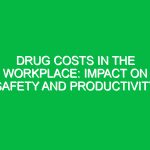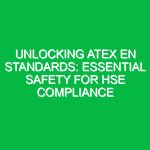Introduction
Assessing areas of risk is a critical process within the Health, Safety, and Environment (HSE) domain. It involves identifying, evaluating, and prioritizing risks that could potentially harm individuals, property, or the environment. This process is not merely a bureaucratic requirement; it is fundamental to cultivating a safe workplace and ensuring compliance with legal standards. By understanding the nuances of assessing areas of risk, organizations can implement effective safety measures, foster a culture of safety, and ultimately achieve operational success.
In this guide, we will explore the intricacies of assessing areas of risk, the methodologies involved, and the regulations that govern this essential process. Through real-life examples and actionable insights, we aim to provide a comprehensive understanding of how risk assessment contributes to safety success within the HSE framework.
Understanding Risk Assessment in HSE
Risk assessment is the systematic process of evaluating potential risks that may be involved in a projected activity or undertaking. In the HSE context, this means identifying hazards, analyzing and evaluating the associated risks, and determining appropriate measures to mitigate those risks.
The Importance of Risk Assessment
The significance of assessing areas of risk cannot be overstated. Risks are inherent in every workplace, and understanding them is crucial for several reasons:
- Protection of Employees: A thorough risk assessment helps safeguard employees’ health and well-being by identifying potential hazards that could lead to injury or illness.
- Regulatory Compliance: Many industries are governed by stringent regulations that mandate regular risk assessments, ensuring organizations adhere to safety standards.
- Operational Efficiency: By addressing risks proactively, organizations can avoid costly accidents and downtime, thus enhancing overall productivity.
- Reputation Management: Companies known for prioritizing safety often enjoy better reputations, leading to increased trust from clients and stakeholders.
Components of Risk Assessment
Assessing areas of risk involves several key components:
- Hazard Identification: This is the first step in the risk assessment process. It involves recognizing anything that may cause harm, such as chemicals, machinery, or unsafe working conditions.
- Risk Analysis: After identifying hazards, the next step is to analyze the potential for harm and the likelihood of an incident occurring. This often involves both qualitative and quantitative assessments.
- Risk Evaluation: Here, risks are prioritized based on their potential impact and likelihood. This helps organizations focus on the most critical areas that require immediate attention.
- Control Measures: Finally, organizations must determine appropriate control measures to mitigate identified risks, which may include engineering controls, administrative policies, or personal protective equipment (PPE).
Methodologies for Assessing Areas of Risk
There are several methodologies that organizations can adopt when assessing areas of risk. Each approach has its advantages and can be tailored to suit specific workplace needs.
Qualitative Risk Assessment
Qualitative risk assessment involves subjective judgment about the likelihood and impact of risks. This method is often used when there is limited data available. For example, a construction company might conduct a qualitative assessment to identify potential fall hazards on a new job site. The team would gather insights from employees, conduct site inspections, and utilize past incident reports to inform their evaluation.
Quantitative Risk Assessment
In contrast, quantitative risk assessment relies on numerical data to evaluate risks. This approach involves statistical analysis to determine the likelihood of an event occurring and its potential impact. For instance, a chemical manufacturing plant might use historical data on chemical spills to calculate the probability of a spill occurring and the possible consequences. This method can provide a more precise picture of risks, but it often requires sophisticated tools and expertise.
Bow-Tie Analysis
Bow-tie analysis is a visual tool that helps organizations understand the relationship between potential hazards, preventive measures, and recovery actions. It provides a comprehensive view of how risks can be managed from both sides—prevention and mitigation. For example, in a maritime context, a bow-tie diagram could illustrate how crew training (preventive measure) and emergency drills (recovery action) can mitigate the risk of a ship capsizing.
Best Practices for Effective Risk Assessment
To ensure the effectiveness of assessing areas of risk, organizations should consider adopting the following best practices:
Engagement of Employees
Involving employees in the risk assessment process is vital. They are often the most familiar with the hazards present in their work environment. For instance, during a risk assessment workshop, employees may identify risks that management overlooks, leading to more comprehensive evaluations.
Regular Reviews and Updates
Risk assessments should not be a one-time exercise. Regularly reviewing and updating assessments ensures that they remain relevant as conditions change—be it new equipment, processes, or regulations. A manufacturing facility, for example, should reassess its risks whenever a new machine is introduced or a new product is launched.
Documentation and Communication
Maintaining thorough documentation of risk assessments is essential for accountability and compliance. Additionally, communicating findings and control measures to all employees fosters a culture of safety. For instance, a construction site that holds regular safety meetings to discuss risk assessment findings can enhance awareness and engagement among workers.
Identifying Potential Hazards and Risks
When assessing areas of risk, organizations must be vigilant in identifying potential hazards. Hazards can be classified into several categories:
- Physical Hazards: These include slips, trips, falls, machinery hazards, and working at heights.
- Chemical Hazards: Exposure to harmful substances, including toxic chemicals, flammable materials, and corrosive agents.
- Biological Hazards: Risks arising from exposure to bacteria, viruses, and other pathogens, often relevant in healthcare settings.
- Ergonomic Hazards: Poor workstation design or repetitive movements that can lead to musculoskeletal disorders.
- Psychosocial Hazards: Stress, harassment, or violence in the workplace that can impact mental health and well-being.
Regulations and Standards Governing Risk Assessment
Several regulations and standards govern the risk assessment process across various industries. Understanding these legal requirements is crucial for compliance and safety success.
OSHA Standards
In the United States, the Occupational Safety and Health Administration (OSHA) mandates that employers conduct regular risk assessments to maintain a safe working environment. OSHA standards require that employers identify hazards and implement necessary measures to prevent workplace injuries.
ISO 45001
ISO 45001 is an international standard that outlines requirements for an occupational health and safety management system (OHSMS). This standard emphasizes the importance of risk assessment in improving workplace safety and requires organizations to assess risks and opportunities associated with their OHSMS.
Environmental Regulations
Various environmental regulations, such as the Environmental Protection Agency (EPA) guidelines, also require organizations to assess environmental risks associated with their operations. This includes evaluating the potential impact of waste disposal, emissions, and resource use on the environment.
Conclusion
Assessing areas of risk is integral to maintaining health, safety, and environmental standards in any organization. By understanding the processes involved in risk assessment, engaging employees, and adhering to regulatory requirements, organizations can significantly enhance workplace safety and operational efficiency.
The commitment to ongoing risk assessment not only protects employees but also contributes to a sustainable business model that prioritizes health, safety, and environmental stewardship. In an ever-evolving landscape of risks, organizations must remain vigilant and proactive in their approach to risk management. Embrace the challenge of assessing areas of risk, and pave the way for a safer, more successful future.


